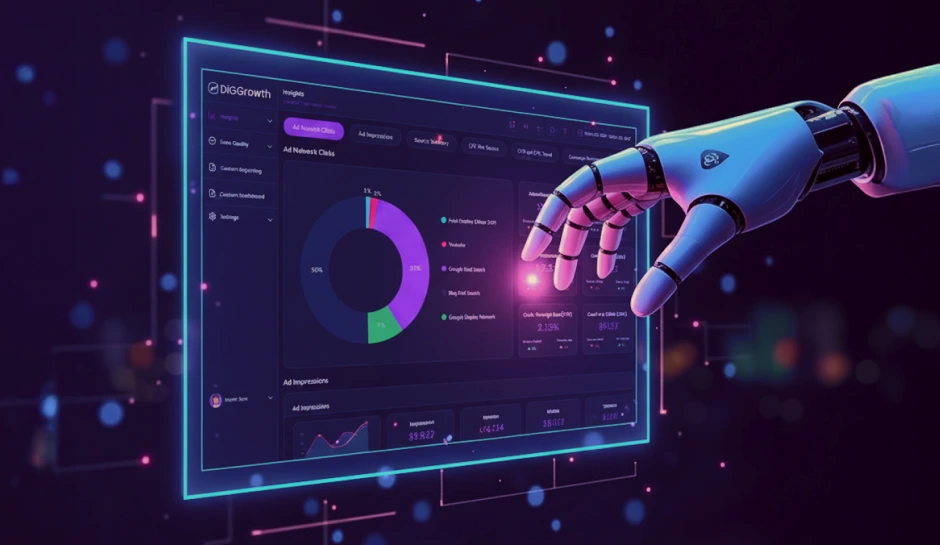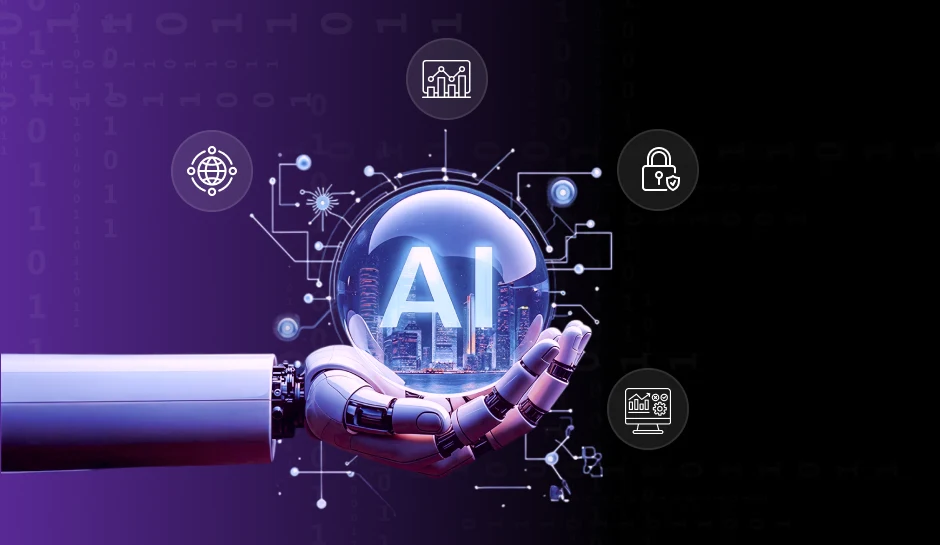
Large Language Models and Knowledge Graphs: Driving Innovation and Efficiency
The Impact of Large Language Models on Knowledge Management With technological advancements, Large Language Models are revolutionizing business insights, efficiency, and strategic decision-making. This integration enhances enterprise knowledge management, offering actionable strategies, insights, and innovative solutions. This blog explores the transformative impact on sustainable growth, competitive advantage, and optimizing organizational capabilities.
The tried and tested tools that businesses once relied on for managing data are starting to show their limitations. This isn’t just a minor hiccup; it’s a clear signal that a change is needed. Enter integrating large language models (LLMs) with enterprise knowledge graphs. This combination isn’t merely about updating old methods but revolutionizing how companies understand and use their data.
By blending these advanced language models with structured knowledge graphs, businesses can gain deeper insights, make better decisions, and navigate the complexities of modern data challenges with newfound clarity.
This blog will delve into the intricacies of this strategic alliance, highlighting its potential to reshape business strategies and outcomes today.
Understanding Enterprise Knowledge Graphs
Enterprise Knowledge Graphs represent a structured approach to organizing and connecting data within large-scale organizational ecosystems. Unlike traditional databases that store information in isolated silos, Knowledge Graphs offer a cohesive framework that maps out relationships and hierarchies among various data elements.
Distinct Features of Enterprise Knowledge Graphs
- Semantic Connectivity:
- Dynamic Scalability:
- Relationship Mapping:
- Interoperability:
Establishes semantic connections between disparate data points, enabling contextual understanding and analysis.
Designed to accommodate evolving data landscapes, Knowledge Graphs offer scalability to handle growing volumes of structured and unstructured data effectively.
Mapping intricate relationships between entities, facilitating holistic insights and predictive analytics.
Promotes interoperability by integrating data from diverse sources, ensuring consistency and coherence across organizational datasets.
Empowering Organizations with Structured Data Insights
- Informed Decision-Making:
- Enhanced Data Discoverability:
- Optimized Operations:
- Risk Mitigation:
Knowledge Graphs empower decision-makers with real-time information and predictive analytics capabilities by synthesizing complex datasets into actionable insights.
Organizations can navigate their data landscape more effectively, uncovering hidden patterns, trends, and opportunities that drive strategic initiatives.
Knowledge Graphs enable organizations to optimize operational efficiencies and resource allocation, from streamlining workflows to automating repetitive tasks.
Knowledge Graphs facilitate proactive risk management and compliance monitoring by providing a comprehensive view of organizational data assets and relationships.
The Role of LLMs in Enhancing Knowledge Graphs
Having explored the foundational aspects of Enterprise Knowledge Graphs, it’s essential to understand how Large Language Models (LLMs) contribute to enhancing their capabilities. LLMs introduce a level of semantic depth and precision that significantly amplifies the efficacy and intelligence of Knowledge Graphs.
Infusing Semantic Understanding
- Contextual Depth:
- Interpreting Nuances:
- Advancements in NLP:
Unlike conventional methods that rely on surface-level patterns, LLMs offer a nuanced understanding of context. This enables Knowledge Graphs to capture intricate relationships and nuances within data, enhancing the quality and relevance of insights derived.
LLMs can discern subtle nuances within textual data, ensuring the semantic context is accurately captured. This proficiency in natural language understanding enables Knowledge Graphs to represent data more comprehensively and contextually relevantly.
Through sophisticated Natural Language Processing (NLP) techniques, LLMs facilitate the interpretation and analysis of unstructured textual data. This capability is pivotal for Knowledge Graphs, especially when assimilating and contextualizing diverse data sources.
Automating Key Functions with LLMs
Automated Entity Recognition: Large Language Models excel in automating identifying and categorizing entities within textual data. This automated entity recognition capability streamlines the data population process within Knowledge Graphs, ensuring accuracy and consistency.
- Facilitating Relationship Extraction:
- Enabling Data Linking and Integration:
Extracts and maps relationships between entities within Knowledge Graphs. Large Language Models enhances the granularity and complexity of relationship mapping, and facilitates more comprehensive insights and analyses.
LLMs significantly contribute to seamless data linking and integration across diverse domains and formats within Knowledge Graphs. It ensures that Knowledge Graphs evolve as dynamic, interconnected ecosystems capable of adapting to evolving business requirements.
Considerations for Integrating LLMs with Knowledge Graphs
Design Principles and Best Practices
- Modularity:
- Standardized Data Models:
- Interoperability Standards:
- Data Governance Framework:
- User-Centric Design:
- Infrastructure Scalability:
- Optimized Processing Pipelines:
Adopt a modular design approach to facilitate seamless integration and updates, ensuring adaptability and scalability without necessitating comprehensive system overhauls.
Harmonize data models and ontologies between LLMs and Knowledge Graphs to ensure consistent data representation, interpretation, and integration, enhancing interoperability across organizational datasets.
Adhere to industry-standard protocols and APIs to streamline data exchange, facilitate system integration, and support seamless collaboration across diverse platforms and applications.
Implement a robust framework to ensure data quality, consistency, security, and compliance across LLM-enhanced Knowledge Graphs, fostering trust and reliability.
Prioritize user-centric design principles to enhance usability, accessibility, and user adoption of LLM-enhanced Knowledge Graphs, ensuring intuitive navigation, visualization, and interaction.
Leverage scalable storage solutions, distributed computing architectures, and cloud-native frameworks to accommodate evolving data volumes, computational demands, and user interactions effectively.
Implement efficient processing pipelines, incorporating parallel processing, data caching, and partitioning strategies to facilitate efficient data management, retrieval, and visualization, ensuring responsiveness and performance.
The Future of Large Language Models (LLMs) and Knowledge Graphs
As advancements in Large Language Models (LLMs) research evolve, we anticipate transformative shifts that redefine enterprise knowledge management strategies, capabilities, and outcomes.
- Enhanced Data Intelligence
- Personalized User Experiences
- Ethical and Responsible AI
Future advancements in LLMs will enable organizations to extract deeper insights, discover hidden patterns, and
unlock untapped opportunities within vast and complex datasets. This enhanced data intelligence will empower decision-makers, foster innovation, and drive strategic initiatives with unparalleled precision and foresight.
Integrating LLMs with Knowledge Graphs will facilitate the delivery of personalized user experiences, tailored recommendations, and context-aware interactions across diverse applications, platforms, and touchpoints. This personalized approach will enhance user engagement, satisfaction, and loyalty, fostering sustainable growth and competitive differentiation.
As LLM technologies mature, organizations must prioritize ethical considerations, data privacy, transparency, and accountability to ensure responsible AI deployment. By fostering a culture of ethical integrity and regulatory compliance, enterprises can build trust, mitigate risks, and uphold societal values while leveraging the transformative potential of LLM-enhanced Knowledge Graphs.
Challenges and Solutions in Integrating LLMs with Knowledge Graphs
Scalability Constraints
- Challenge:
- Challenge:
- Solution:
Integrating LLMs may strain computational resources, affecting processing speed and storage.
Solution: Implement scalable infrastructure solutions, such as cloud-based architectures, distributed computing frameworks, and optimized algorithms, to accommodate growing data volumes and computational demands effectively.
Semantic Ambiguity
LLMs may introduce semantic ambiguity, leading to inaccurate data interpretations within Knowledge Graphs.
Employ semantic validation mechanisms, context-aware algorithms, and domain-specific ontologies to enhance data accuracy, consistency, and relevance, thereby mitigating semantic ambiguity.
Integration Complexity
- Challenge:
- Solution:
Integrating LLMs with existing Knowledge Graph architectures may introduce data mapping, transformation, and system interoperability complexities.
Adopt a phased integration approach, and leverage standardized APIs, modular design principles, and middleware solutions to facilitate seamless data integration, synchronization, and collaboration across diverse platforms and applications.
Data Privacy and Security
- Challenge:
- Solution:
- Challenge:
- Solution:
Ensuring data privacy and security in LLM-enhanced Knowledge Graphs requires safeguarding sensitive information, complying with regulatory requirements, and protecting against unauthorized access or breaches.
Implement encryption, access controls, anonymization, masking, and robust data governance to protect sensitive data, ensure privacy compliance, and reduce security risks.
Transparency and Accountability
Maintaining transparency and accountability in LLMs’ integration with Knowledge Graphs is crucial for trust, auditability, and ethical adherence.
Use explainable AI, ethical guidelines, governance, and clear documentation to ensure transparency, accountability, and stakeholder trust, enhancing ethical integrity and organizational responsibility.
Conclusion
The synergy between Large Language Models (LLMs) and Knowledge Graphs reshapes enterprise knowledge management, unlocking unparalleled insights and competitive advantages. As advancements in LLM technologies continue to redefine business landscapes, strategic integration, ethical considerations, and innovation emerge as critical imperatives for maximizing transformative value. Embracing this transformative potential positions organizations to optimize operations, drive innovation, and secure a sustainable competitive edge in an interconnected world.
Leverage the benefits of GA4 Looker Studio Connector with DiGGrowth. Talk to Us!
To seek our expert assistance and services, write to us at info@diggrowth.com and we’ll get back to you.
Ready to get started?
Increase your marketing ROI by 30% with custom dashboards & reports that present a clear picture of marketing effectiveness
Start Free Trial
Experience Premium Marketing Analytics At Budget-Friendly Pricing.

Learn how you can accurately measure return on marketing investment.
Additional Resources
How Predictive AI Will Transform Paid Media Strategy in 2026
Paid media isn’t a channel game anymore, it’s...
Read full post postDon’t Let AI Break Your Brand: What Every CMO Should Know
AI isn’t just another marketing tool. It’s changing...
Read full post postFrom Demos to Deployment: Why MCP Is the Foundation of Agentic AI
A quiet revolution is unfolding in AI. And...
Read full post postFAQ’s
Knowledge Graphs offer structured data insights, enabling Large Language Models to achieve deeper context, precision, and relevance in text generation and understanding.
An Enterprise Knowledge Graph is an organization's refined data structure, synthesizing diverse data sets to drive insights, informed decisions, and cross-functional collaboration.
Knowledge Graphs act as semantic frameworks in NLP, facilitating advanced entity recognition, relationship mapping, and contextual analysis to enhance text interpretation and generation.
Graph algorithms are instrumental in analyzing and refining Knowledge Graph structures, enabling Large Language Models to interpret interconnected data relationships more effectively, enhancing performance, accuracy, and semantic coherence in text processing.


